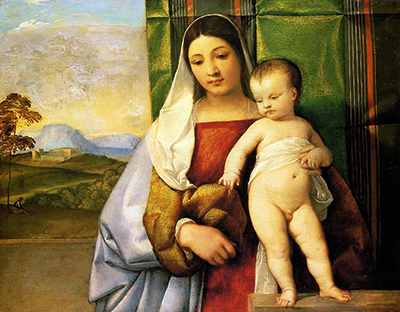The Gypsy Madonna by Titan is a Madonna and Child panel painting in oils from around 1510 to 1511. It's now in Kunsthistorisches Museum, an art museum in Vienna.
The painting was made for display in a house instead of a church. It's close to compositions by Giovanni Bellini, who is Titian's former master, especially when it is reversed. The style is indebted to Giorgione, born Giorgio Barbarelli da Castelfranco, and in the earlier twentieth century, it was usually attributed to him. This is especially in the case of the slow gravity of form and harmonious fullness of the Virgin's figure, which uses a sort of figure Titian didn't repeat in later Madonnas. Looking at the painting, the landscape is essentially the same as the left-most background section of the Dresden Venus, which is traditionally believed to have been started by Giorgione; however, the landscape was done by Titian in 1510 after his death. A cloth of honour occupies the right background; its folds have been painted with careful attention (they were usually stored folded up).
As in most of the paintings of enthroned Madonnas, they were hung behind thrones. Here, it is implying a throne that's unoccupied to the right and out of sight. The Bellini in Detroit also uses the same device. Therefore, the composition is in the middle of the more formal, older enthroned Madonnas and the newer works that have the Virgin and Child displayed in a landscape setting in an informal way. For some time, Madonnas by Bellini together with his followers had been showing little glimpses of the "landscape" to the painting's sides, often cut off by a wall lower down. Here, the formula, using a format called horizontal "landscape", develops this.
Just like several other significant early Venetian paintings in the city of Vienna, the painting was probably in the Venetian Bartolomeo della Nave collection, and it was sold in Venice to James Hamilton, also known as the Duke of Hamilton. Hamilton brought it to London; after his execution in 1659, Archduke Leopold Wilhelm acquired the painting. Leopold Wilhelm's collection passed to the imperial collection located in Vienna.
The Gypsy Madonna is known to be a nineteenth-century name for the picture because of the supposed dusky complexion plus dark hair and eyes of the Virgin. She looks young even by the Madonnas standards, and the Child's hands are often engaged, respectively with the fingers of his mother and her dress.
According to Sydney Joseph Freedberg, an art historian and curator, the sensuous existence effect Titan made by his optical device command is of an extreme mastery. There is no other painting before this that has attained a similar sense of presences existing clearly within an atmosphere and reflects coloured light but absorbs it to saturation point as well so that every pore of drapery or flesh makes texture. Despite the claims to Giorgione and Bellini, this picture shows Titian, who was 21 years old at that time, developing his independent character and style.




